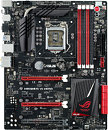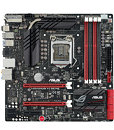- Joined
- Oct 9, 2007
- Messages
- 47,230 (7.55/day)
- Location
- Hyderabad, India
| System Name | RBMK-1000 |
|---|---|
| Processor | AMD Ryzen 7 5700G |
| Motherboard | ASUS ROG Strix B450-E Gaming |
| Cooling | DeepCool Gammax L240 V2 |
| Memory | 2x 8GB G.Skill Sniper X |
| Video Card(s) | Palit GeForce RTX 2080 SUPER GameRock |
| Storage | Western Digital Black NVMe 512GB |
| Display(s) | BenQ 1440p 60 Hz 27-inch |
| Case | Corsair Carbide 100R |
| Audio Device(s) | ASUS SupremeFX S1220A |
| Power Supply | Cooler Master MWE Gold 650W |
| Mouse | ASUS ROG Strix Impact |
| Keyboard | Gamdias Hermes E2 |
| Software | Windows 11 Pro |
Along with the Z87 mainline (classic) series, ASUS unveiled its premium gamer-overclocker targeted Republic of Gamers (ROG) Maximus VI series, consisting of three models, the Maximus VI Hero, the Maximus VI Gene, and the Maximus VI Extreme. The Maximus VI Hero is the more affordable ATX model among the three; the Maximus VI Gene is the only micro-ATX offering, while the Maximus VI Extreme is the flagship motherboard from ASUS for socket LGA1150.
The Maximus VI Hero offers a 12-phase CPU power supply, most ROG-exclusive features, expansion slots that include three PCI-Express 3.0 x16 (x16/NC/NC or x8/x8/NC or x8/x4/x4), eight SATA 6 Gb/s ports, SupremeFX onboard audio with ground-layer isolation, and essential connectivity options that include four USB 3.0 ports, gigabit Ethernet, and HDMI display output. We won't be surprised if Maximus VI Hero ends up being a sub-$200 option, to compete against similarly priced alternatives from ASRock and MSI.



Next up is the darling of micro-ATX builders, the Maximus VI Gene. This board offers an identical CPU power supply to the Maxiums VI Hero, two PCI-Express 3.0 x16 slots (x16/NC or x8/x8), an open-ended PCI-Express 2.0 x4 (wired to the PCH), connectivity that's largely identical to the Hero, but with the addition of the mPCIe combo card, which gives it 802.11ac WiFi and Bluetooth, and six USB 3.0 ports.
Leading ASUS' LGA1150 lineup is the Maximus VI Extreme. This monstrosity offers the same VRM and overclocking features as the other Maximus VI boards. It gives you the ability to do 3-way and 4-way multi-GPU setups, thanks to its onboard PCI-Express 3.0 x48 bridge chip, which gives you four PCI-Express 3.0 x16 slots, two of which are electrically x16 capable, while all four run at least x8. Other expansion slots include a PCI-Express 2.0 x16 (electrical x4) wired to the PCH, and an open-ended PCI-Express 2.0 x4. Strangely, this board doesn't feature onboard SupremeFX audio, but a simpler Realtek-based solution. It likely includes an add-on sound-card. Other connectivity options include two gigabit Ethernet interfaces, ten SATA 6 Gb/s ports, eight USB 3.0, and a few exclusive overclocker-friendly features that the other two lack.
View at TechPowerUp Main Site
The Maximus VI Hero offers a 12-phase CPU power supply, most ROG-exclusive features, expansion slots that include three PCI-Express 3.0 x16 (x16/NC/NC or x8/x8/NC or x8/x4/x4), eight SATA 6 Gb/s ports, SupremeFX onboard audio with ground-layer isolation, and essential connectivity options that include four USB 3.0 ports, gigabit Ethernet, and HDMI display output. We won't be surprised if Maximus VI Hero ends up being a sub-$200 option, to compete against similarly priced alternatives from ASRock and MSI.



Next up is the darling of micro-ATX builders, the Maximus VI Gene. This board offers an identical CPU power supply to the Maxiums VI Hero, two PCI-Express 3.0 x16 slots (x16/NC or x8/x8), an open-ended PCI-Express 2.0 x4 (wired to the PCH), connectivity that's largely identical to the Hero, but with the addition of the mPCIe combo card, which gives it 802.11ac WiFi and Bluetooth, and six USB 3.0 ports.
Leading ASUS' LGA1150 lineup is the Maximus VI Extreme. This monstrosity offers the same VRM and overclocking features as the other Maximus VI boards. It gives you the ability to do 3-way and 4-way multi-GPU setups, thanks to its onboard PCI-Express 3.0 x48 bridge chip, which gives you four PCI-Express 3.0 x16 slots, two of which are electrically x16 capable, while all four run at least x8. Other expansion slots include a PCI-Express 2.0 x16 (electrical x4) wired to the PCH, and an open-ended PCI-Express 2.0 x4. Strangely, this board doesn't feature onboard SupremeFX audio, but a simpler Realtek-based solution. It likely includes an add-on sound-card. Other connectivity options include two gigabit Ethernet interfaces, ten SATA 6 Gb/s ports, eight USB 3.0, and a few exclusive overclocker-friendly features that the other two lack.
View at TechPowerUp Main Site





 wonder if there will be a bundle with it for the Dayz standalone would be cool.
wonder if there will be a bundle with it for the Dayz standalone would be cool.


 That was one of the very few reasons i bought these boards.
That was one of the very few reasons i bought these boards.

